
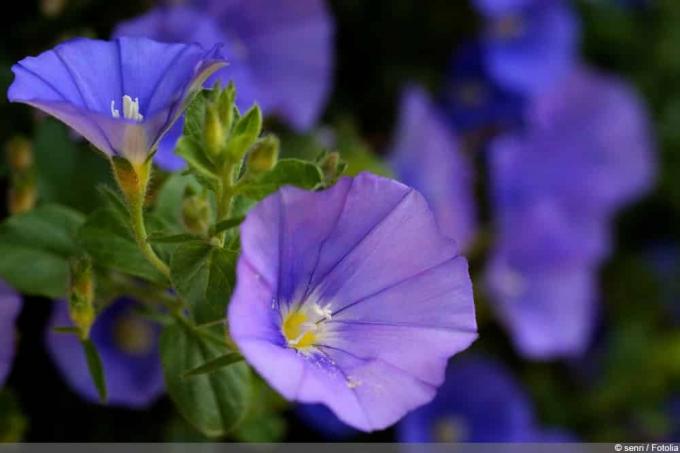
Table of contents
- use
- location and growth height
- soil and origin
- Sufficient fertilizer
- Pour
- Valuable care instructions
- propagation and planting
- The propagation
- This is how the Blue Mauritius overwinters
- The winter protection
- pests
- The Blue Mauritius - care tips
- Care profile Blue Mauritius:
- soil condition
- irrigation
- Fertilize
- flower care
The Blue Mauritius is one of the most beautiful and lush flowering plants that presents a veritable sea of flowers with appropriate care. With their climbing and hanging habit, the dainty open flowers form a beautiful contrast to the light green, slightly silvery foliage.
use
Also known by the botanical name Convolvulus sabatius, the Blue Mauritius comes from the morning glory family. It is wonderfully suited for summer planting, for cool conservatories, rockeries and planters. But the attractive ornamental plant is also an absolute eye-catcher in hanging baskets and balcony boxes.
location and growth height
The Blue Mauritius, which can reach an approximate size of up to 50 centimetres, feels most comfortable in full sun. Regular exposure to the sun has a positive effect on the growth of leafy greens and the quantity of flowers, among other things. Depending on its positioning (e.g. in hanging baskets or balcony boxes), the bindweed shows a hanging or climbing growth.

The creeping morning glory is a true sun worshiper. Because if you get a bright and very sunny location, you will not only thank it with a rich bloom, but also with lush foliage. However, the Blue Mauritius also gets along quite well in a partially shaded location. Its light blue to light purple funnel flowers close in the evening and in bad weather to protect the little ones Plant, because the charming ornamental flower is one of the smaller ones with a growth height of between 15 and 40 cm plant representatives.
soil and origin
Like its famous namesake, the world's most famous stamp, the Blue Mauritius is at home on the island of Mauritius of the same name. In addition, the attractive plant also occurs in Sicily, Italy and on dry limestone rocks in north-west Africa. The beautiful creeping morning glory has been cultivated since 1860 and is a perennial plant in our latitudes, which makes some demands on the soil conditions. Here's how she prefers:
- a nutritious, fertile one
- loamy-clayey to sandy-loamy soil
- which should be highly permeable
- but can also store moisture
- it is especially ideal if the soil has a small amount of lime
- compost
- or fertilizer in the spring, for example horn shavings is added
- it should also be slightly acidic to slightly alkaline
Sufficient fertilizer
The beautiful ornamental plant is characterized by rapid growth and a magnificent bloom. For this, however, the Blue Mauritius also needs a regular supply of nutrients in the form of generous fertilization, which begins with the first planting.
- Add slow-release fertilizer to the soil when planting for the first time
- a few months later, add liquid fertilizer to the irrigation water
Pour
Especially in the summer months, the water requirement of the Blue Mauritius is very high. It should therefore be watered sufficiently and evenly once a week, but care must be taken to ensure that waterlogging does not occur. Whether watering once a week is sufficient can be seen from the hanging leaves and the top layer of soil. Because if this is already dry, especially on hot days, the plant should be watered several times a week. But beware: the imposing ornamental plant tolerates neither too much drought nor too much moisture!
Tip:
When the weather is wet for a long time or when it is too wet, the creeping wind tends to cause fungal diseases.
Valuable care instructions

The delicate, funnel-shaped flowers grow from May to October. Withered plant parts should be removed regularly so that they can unfold in all their splendor well into autumn. This so-called cleaning out can, on the one hand, significantly promote flower growth and, on the other hand, prevent fungal diseases. Because if the withered and slightly sticky flowers are removed again and again, the fungi have no chance to settle.
Tip:
Seed stocks are to be removed constantly!
propagation and planting
If the impressive ornamental plant is to be planted in the bed, then it can:
- be brought in as a single plant or
- 4 to 11 plants per m²
- alternatively also in small groups up to 3 plants
- at a distance of 30 to 50 cm
The propagation
- takes place from February to April
- or from August to September
- with mature head cuttings without buds and flowers!
- which are put in groups of 2 or 3 in a multi pot plate
- at temperatures of 18 to 20 degrees
- after 3 weeks roots form
- then further culture with a young plant
- in a 10 to 11 cm pot
- alternatively also 3 to 5 plants in a traffic light
- at temperatures between 18 and 20 degrees
- after root formation, temperatures of 12 to 15 degrees are sufficient
- 1 to 2 weeks later, it can then be slightly trimmed
With the substrate, care must be taken to ensure that the pH value is 6.0 so that the salt content is not too high because the Blue Mauritius is particularly sensitive to salt.
Tip:
Pay attention to the respective temperature, because if the heat is too high, the buds will dry up, the foliage will turn yellow and the individual flowers will have a short shelf life!
This is how the Blue Mauritius overwinters
In autumn, the not winter-hardy Blue Mauritius must be brought to its winter quarters before the first frost - to overwinter a bright and cool room with sufficient daylight and temperatures that do not exceed a minimum of 10 °C is suitable fall below Before their hibernation, the Convolvulus sabatius can be cut back generously.
In order to prepare the Blue Mauritius for overwintering, it is advisable to reduce the watering a few weeks before a possible first frost. The background is that the plant needs less moisture in its cooler winter location than during the summer. If the root ball has stored a lot of water when the plant moves into its winter quarters, waterlogging and root damage can occur as a result.
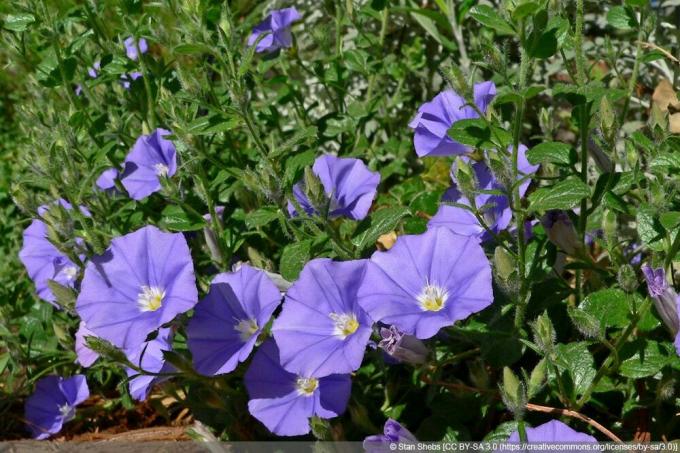
The beautiful ornamental plant is only moderately winter hardy and should be placed in a cool but bright room with sufficient daylight before the first frost. In addition, the winter quarters should not fall below a temperature of 10 degrees. It is also important:
- a generous pruning
- and only moderate watering a few weeks before wintering
- since the plant needs significantly less moisture during the cold season
- and if the root ball is too wet, waterlogging and root damage can occur
The winter protection
The perennial Mauritius is only partially frost hardy, so it should be given some winter protection during the cold season to avoid frost damage.
pests
The ornamental morning glory is attacked by pests such as aphids, spider mites, whitefly and, due to its blue colour, flower thrips.
The Blue Mauritius - care tips
- the Blue Mauritius is a fascinating and perennial plant
- with lush flowers
- which prefers nutrient-rich, loamy-sandy and well-drained soils
- in a sunny location it develops a veritable bloom
- but can also find a place in partial shade
- ideal for bed planting
- for bowls, conservatories and rockeries
- as well as for balcony boxes and traffic lights where they then hang down in an arch
- fertilize sufficiently with a liquid fertilizer
- Water regularly to prevent waterlogging and dehydration
- Flowering period from May to October
- Propagation by perennial cuttings
- the plant is therefore conditionally frost hardy
- she needs a light covering
- Hibernation in bright, cool rooms at 10 degrees
- Pests: spider mites, whitefly, flower thrips, aphids
Care profile Blue Mauritius:
- Ideal location: very sunny
- Suitable substrate: ideally nutrient-rich, loamy soil - supplement with lime if possible
- Water requirement: high
- Fertilizer requirement: high
- Flower care: Remove faded flowers promptly to encourage further growth
- Hardiness: no
- Overwintering: reduce watering before the first frost - overwinter with sufficient daylight and temperatures of approx. 10°C
soil condition
The Blue Mauritius needs nutrient-rich soil that is permeable, but can also store moisture well. In particular, the plant from the willow family prefers loamy substrates. In addition, the Convolvulus sabatius will benefit if a small amount of lime is added to the soil.
irrigation
The liquid requirement of the blue flowering ornamental plant is very high in the summer months. It should therefore be watered sufficiently, whereby waterlogging should be avoided despite the substrate being kept moist. Whether the plant is sufficiently watered after about a week of watering can be easily seen from your Recognize the substrate: The plant should be watered again at the latest when the upper layer of soil has dried become.
Fertilize
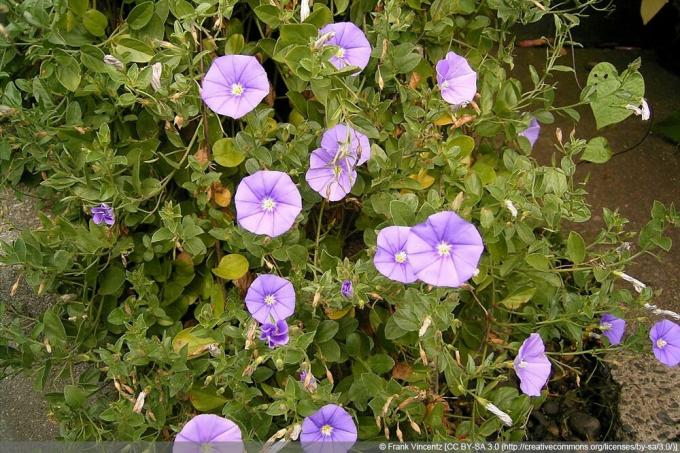
In addition to an adequate water supply, the Blue Mauritius also loves a generous supply of nutrients in the form of fertilizer. The morning glory needs energy from water and fertilizers, among other things because of its comparatively rapid growth and the pronounced formation of flowers. In order to cover the nutrient requirements of the plant, it is possible to provide the potting soil used with long-term fertilizer when planting for the first time. After a few months, the fertilizer that has now been used up can be replaced with liquid fertilizer that is mixed with the irrigation water.
flower care
The large blue flowers of the Blue Mauritius usually grow profusely and appear from May to October. Flower growth can also be stimulated by removing withered parts of the plant at regular intervals. The so-called cleaning out of wilted flowers is mainly used to prevent the formation of seeds. In this way, the Blue Mauritius is stimulated to develop further flowers in order to attract insects and ensure its own reproduction.
In addition, cleaning out wilted morning glory flowers helps prevent fungal diseases – the slightly sticky withered flowers, once removed, no longer provide soil for fungi to colonize can.
 garden editorial
garden editorial I write about everything that interests me in my garden.
Learn more about climbing plants
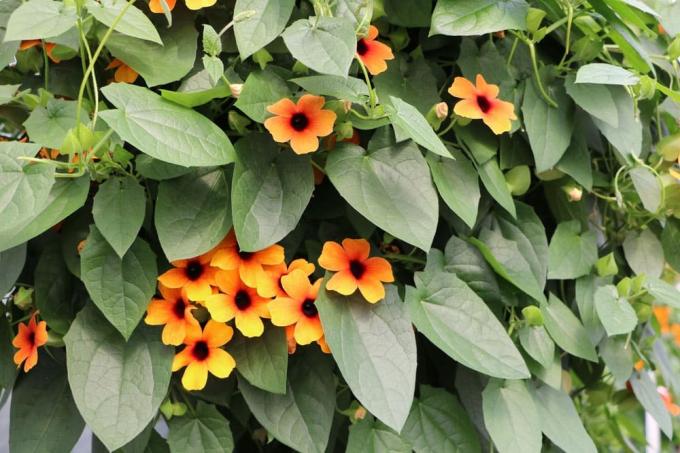
Is black-eyed Susan poisonous?
Black-eyed Susanne can delight all of our eyes with colorful flowers. But if small children or pets are around it, it is important that we also clarify whether it is possibly poisonous. The answer to that is clear and a little surprising!

Black-eyed Susanne, Thunbergia alata: Care from A – Z
Black-eyed Susanne is one of the most popular climbing plants. It is ideal for greening house walls, balconies, fences and pavilions. If you follow our care tips, you will enjoy the splendor of their flowers.
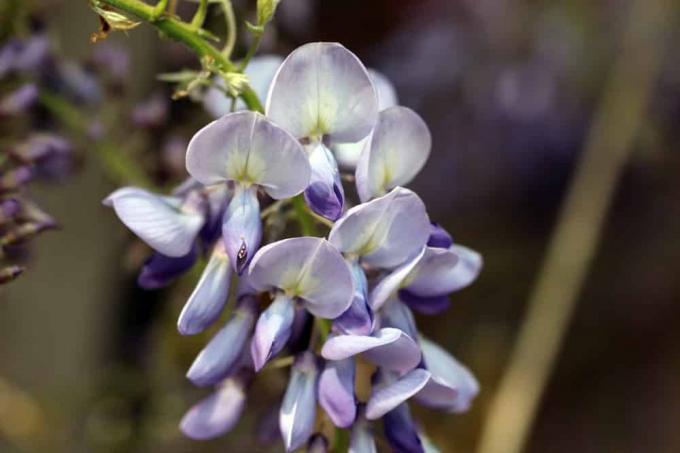
How fast does wisteria grow? | Information about growth
As its name suggests, the wisteria, as an intensive climber, enriches walls, trellis structures and other possibilities for spreading a magnificent, glowing blue sea of flowers. You can find out what you should consider when growing with us in a simple and understandable way.

How fast does Virginia creeper grow? | Information about growth
If you want a trellis or a house wall to be lushly greened, you will find a grateful partner in Virginia creeper. Over time, it can grow into large areas and, especially in autumn, enrich it with colorful foliage. Contact us for helpful information on growth.

Evergreen honeysuckle: care from A to Z
The evergreen honeysuckle is popular for greening walls or fences, because the creeper is green all year round and has beautiful delicate flowers. Although the honeysuckle is not very sensitive, it needs a minimum of care for it to develop well.

How fast does ivy grow? | Accelerate growth effectively
Ivy (Hedera helix) is a true climber that climbs up walls and house walls without any problems and can have a very decorative effect. Once it has taken root, it can literally overgrow large areas in a very short time. You can literally watch him grow.

